¶ Brainstorming
¶ What it is
Brainstorming is a creative technique that encourages out-of-the-box thinking under time constraints to quickly come up with new ideas and approaches to solve a problem. In a safe environment, an individual or group spontaneously gathers a list of ideas.
¶ Why it is useful
Brainstorming is a creative approach that can generate new ideas or alternative ways of tackling a problem. It helps teams to break free from traditional ways of thinking and is the basis for improving service or experience. It supports diverse and innovative ideas.
¶ When to use it
You can use the tool individually or during an ideation workshop. It allows a group of people to brainstorm many ideas simultaneously in a short time. A brainstorming session is often based on the HMW questions you have previously formulated.
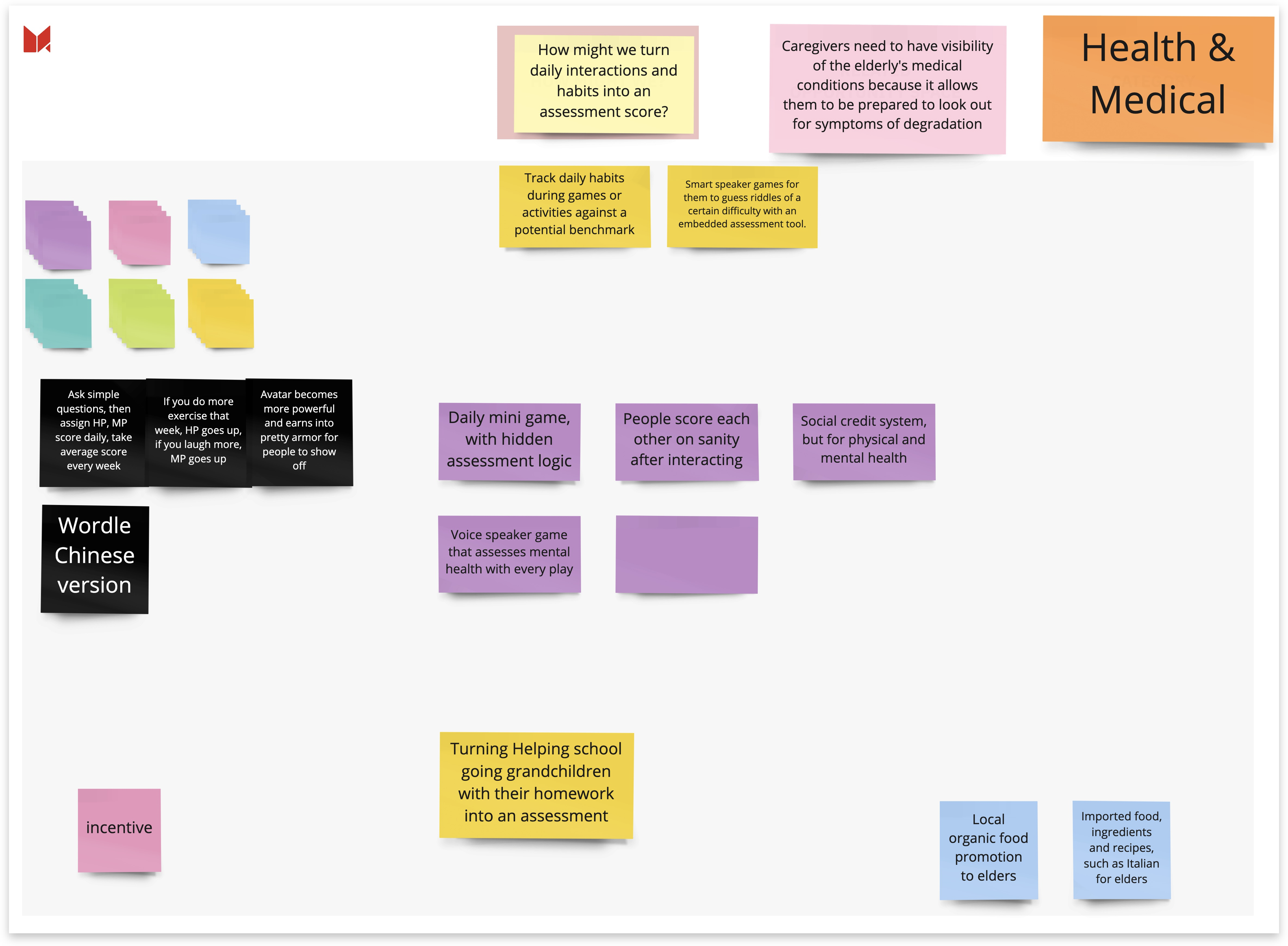
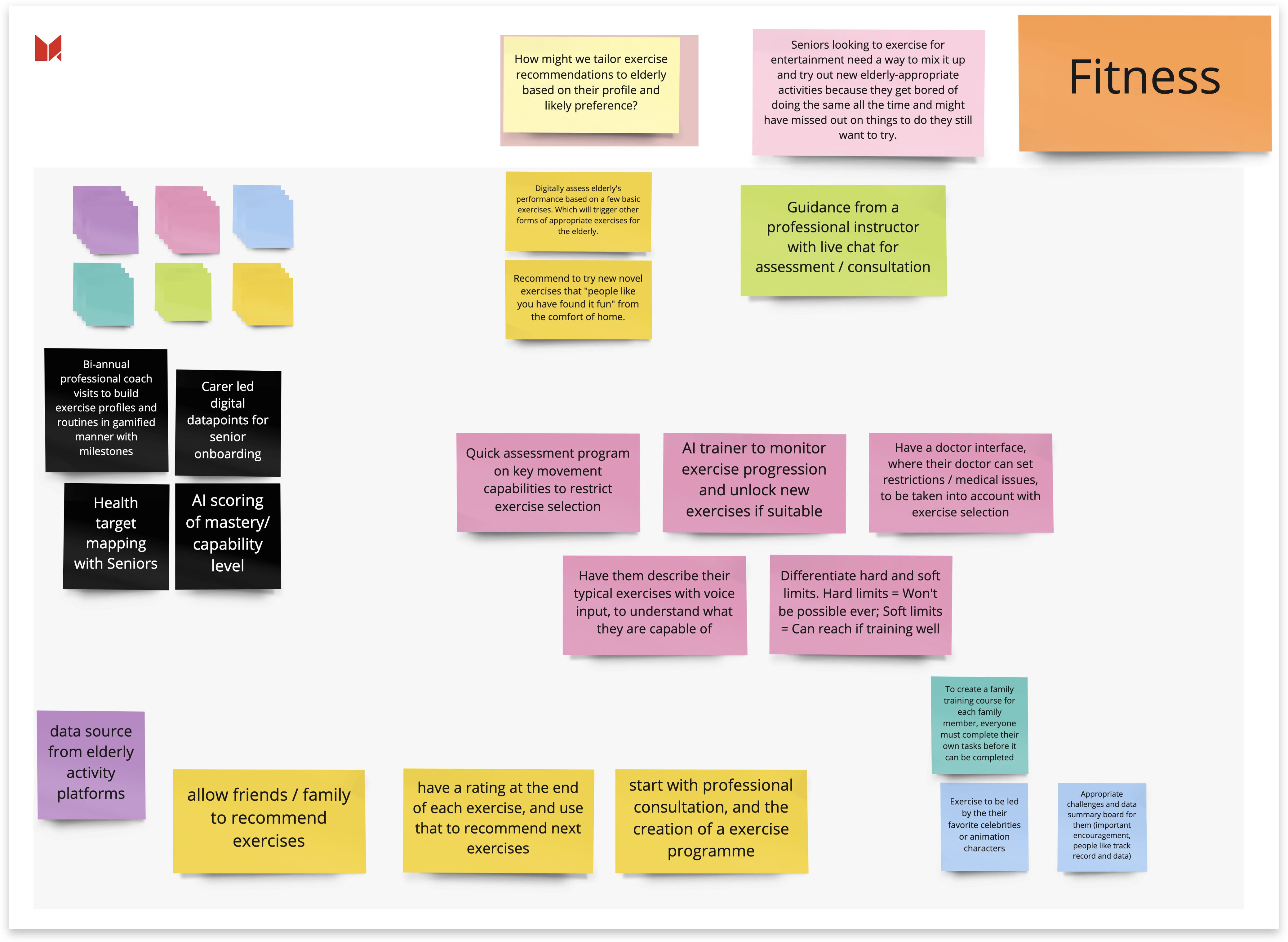
¶
¶ How is it done
- Consider an HMW you have developed.
- Decide on a time that is long enough to develop ideas but still challenges the participants to think quickly (e.g., 10 minutes).
- Set the timer. Take one HMW for each round.
- Individually, take some post-its and write down your ideas or thoughts about the HMW. Develop as many ideas as possible within the given time.
- Stick the post-its on a whiteboard and present them to each other.
¶ Do's & Don't
Do's
- Spin ideas further - follow your thoughts and think beyond current processes or limitations.
- Encourage creative ideas, even if they seem impossible or weird - don’t judge but let the mind think freely and without constraints.
- Aim for quantity - come up with as many ideas as possible.
- Continuously track and document ideas, keep post-its, and digitise content created offline.
Don't
- Refrain from judging or constraining your thinking - write down your first associations without considering whether they make sense.
¶ Tools needed
- Whiteboard (virtual)
- Post-its, paper, pen (virtual)
- HMW question
¶ Example
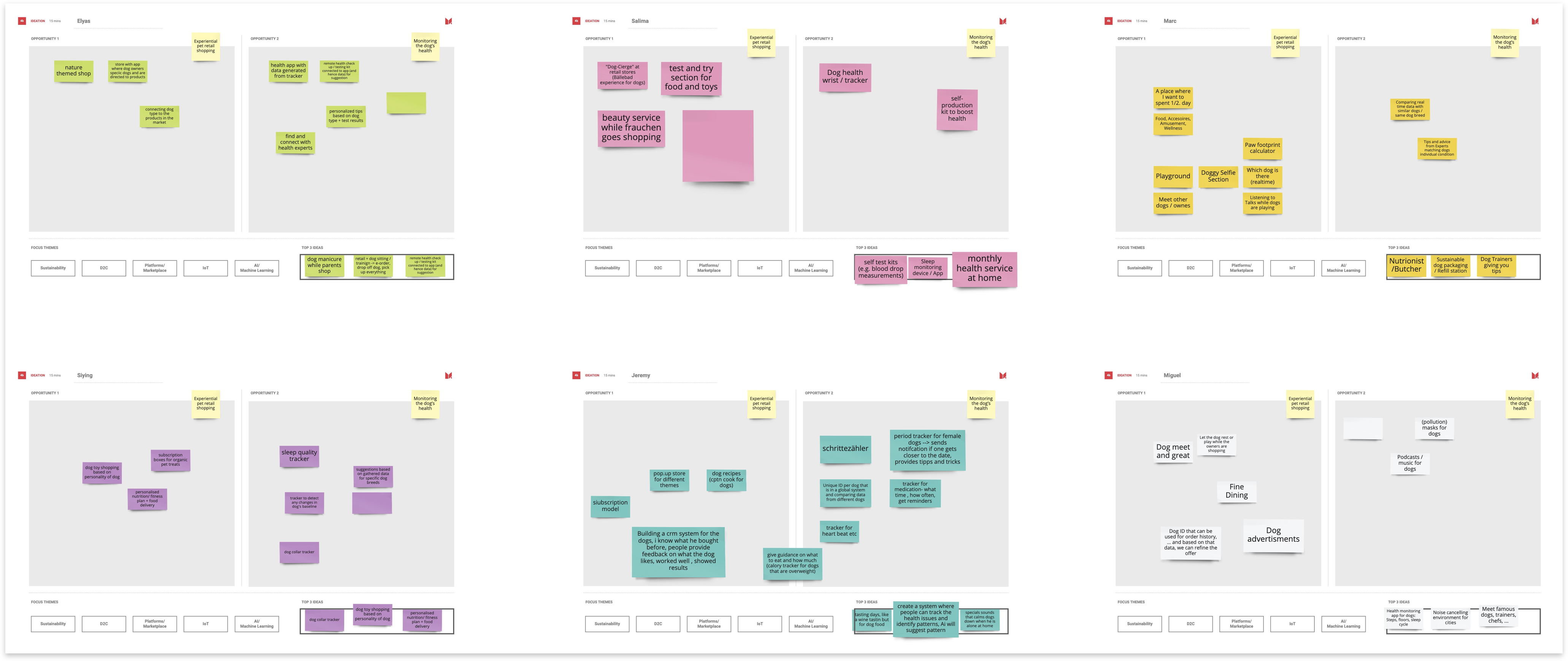
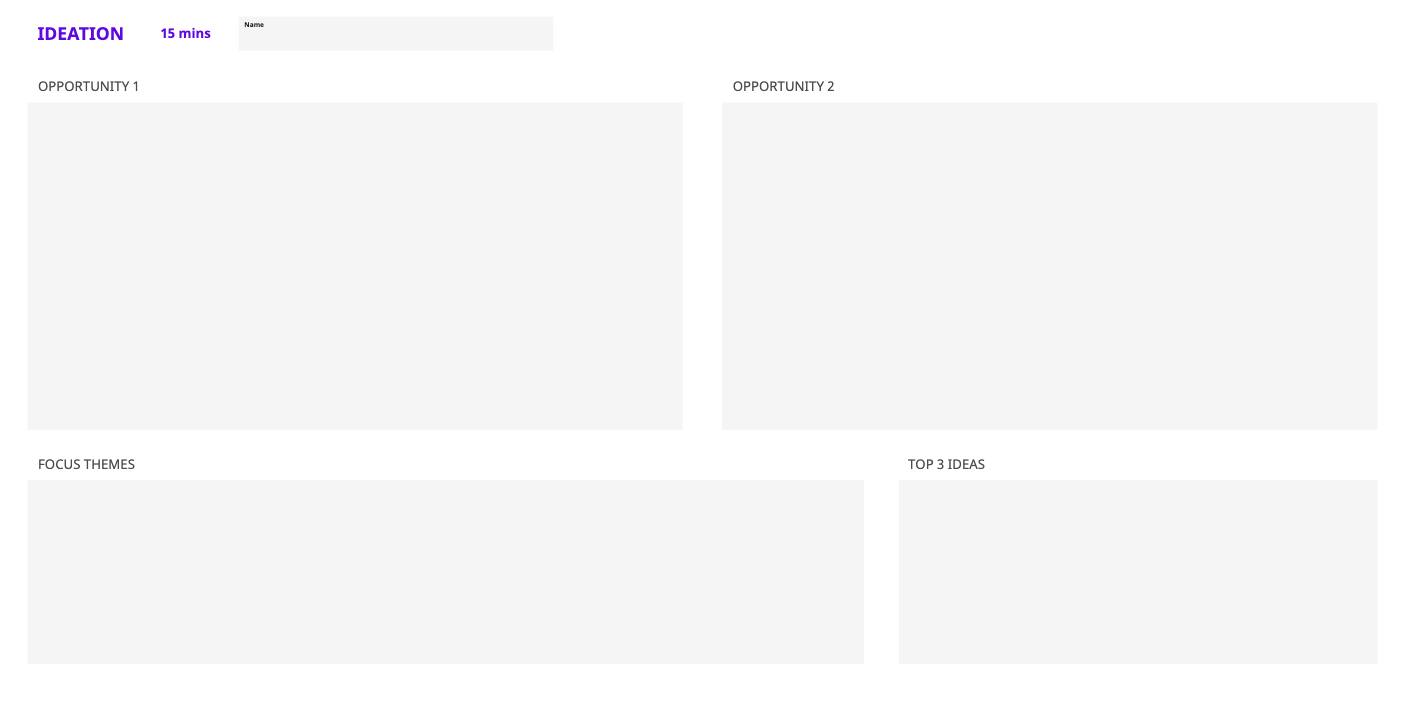
¶ Brainstorming Resources
¶ Method 6-3-5
¶ What it is
In this method, six people individually note three ideas in five minutes. Once time is up, idea sheets are passed on to the other group members to extend ideas. The process is repeated several times until each person has worked on each idea sheet. Of course, this method is not restricted to 6 people; you can adjust according to your setting.
¶ Why it is useful
This method generates many ideas in very little time. In addition, creativity barriers or immediate denunciation are overcome by asking team members to contribute to others’ ideas.
¶ When to use it
This tool is a variation of the Brainstorming tool and can be used during an ideation workshop. It allows a group of people to brainstorm several ideas that different workshop participants elaborate on simultaneously. Like the brainstorming tool, you can use HMW questions as a starting point for this exercise. You can also use this tool in conjunction with brainstorming: say you use "wild" brainstorming first and then use the 6-3-5 method for a selection.

¶
¶ How is it done
- Prepare one worksheet per team member. This tool is planned for six people but can be adjusted more or less.
- Write one HMW on the top.
- Draw a grid with four columns on each worksheet. Leave one column for people’s names and label the other columns “Idea 1”, “Idea 2,” and “Idea 3”.
- Set the timer to 5 minutes.
- In 5 minutes, every team member writes their name in the top row and writes one idea with a short description in each column.
- When time is up, each worksheet is passed on to the person on the right. Everyone writes their name in the second row. The timer is set to 5 minutes again, and everyone expands and reflects on the existing ideas on the worksheet.
- Repeat until every member has commented on every worksheet.
- Remove duplicates and put the worksheets on the whiteboard. Present your ideas to the group and discuss them.
¶ Do's & Don't
Do's
- Ask every team member to be silent during the exercise. Ideas can be discussed later.
- You can create the worksheets on paper or on a whiteboard to pin down the ideas on sticky notes.
- Make rows and columns big enough for idea descriptions.
Don't
- Don’t judge ideas; try to embrace them and build on them.
- Don’t try to correct others; just go with the flow.
¶ Tools needed
- Timer
- Whiteboard (virtual)
- Post-its, paper, pen (virtual)
- HMW question
¶ Example
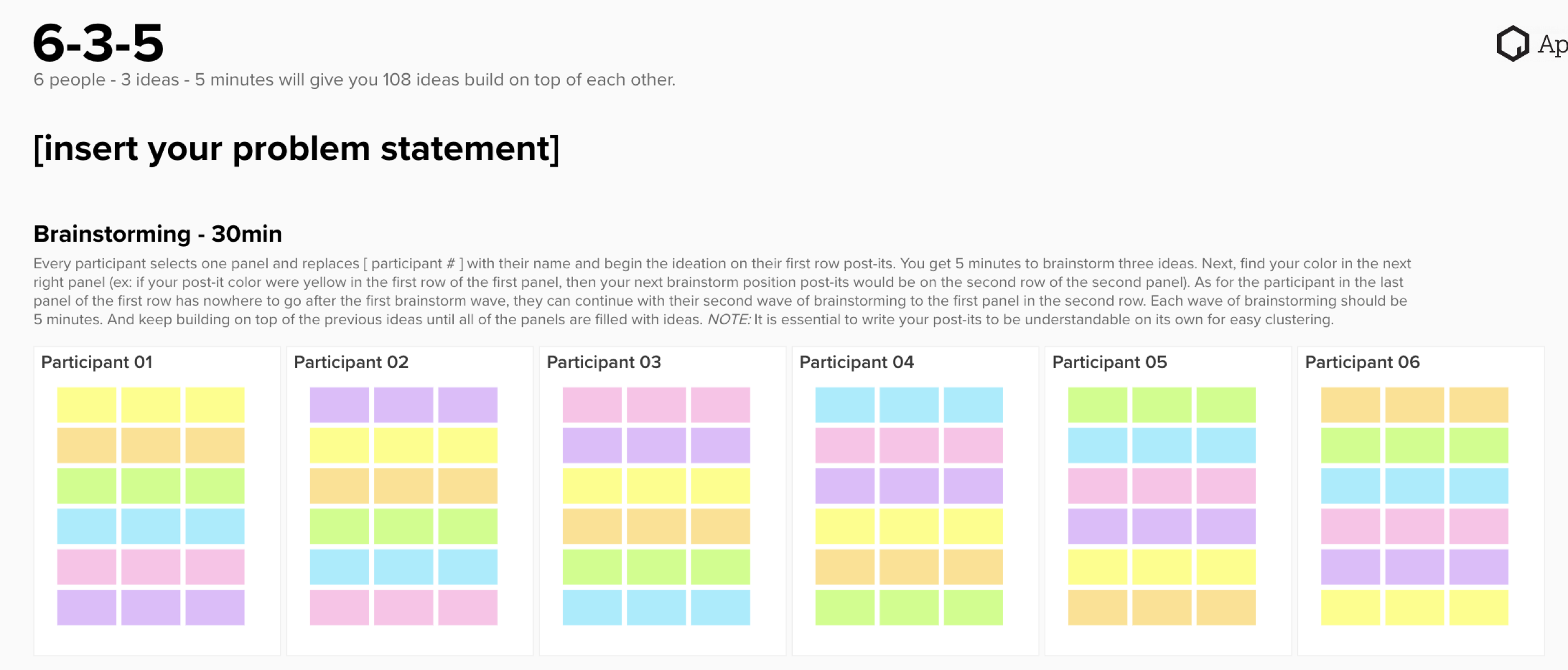
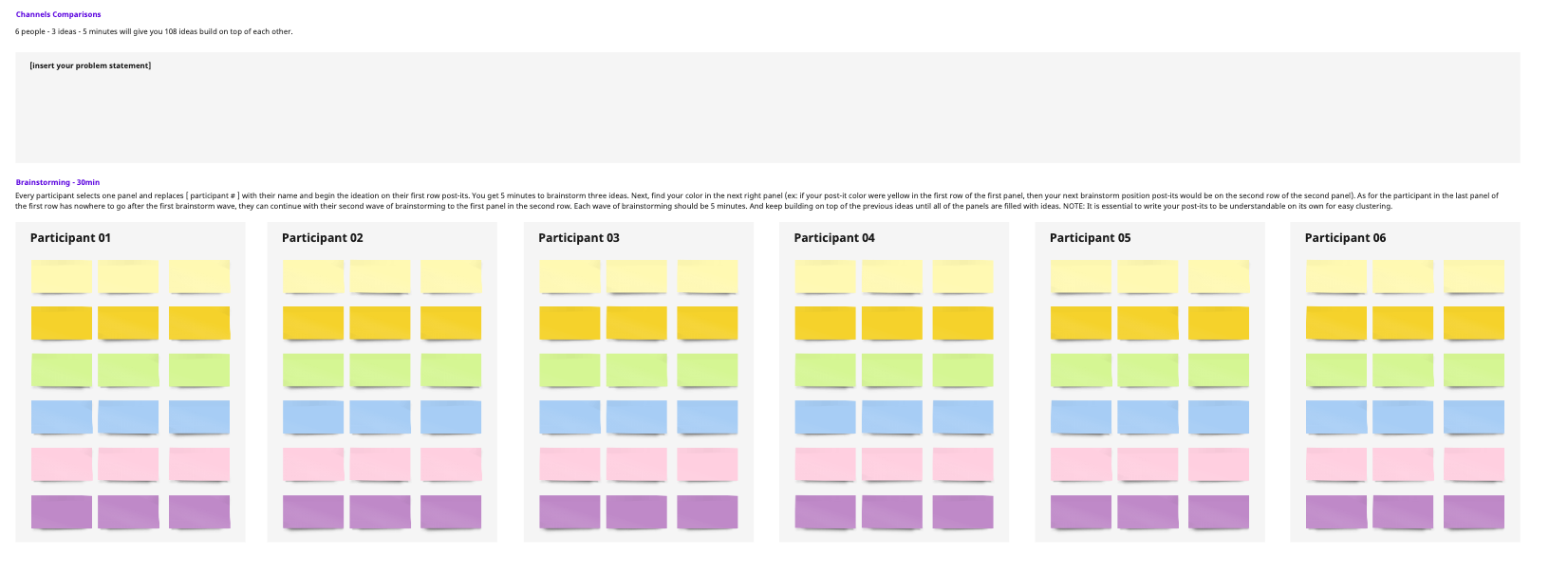
¶ Method 6-3-5 Resources
¶ Reverse Thinking
¶ What it is
Instead of thinking about how to improve a service or experience best, Reverse Thinking flips the question and asks how you could make it the worst, most challenging, or unpleasant.
¶ Why it is useful
By considering the opposite of the optimal solution, you can generate new and creative ideas from a different perspective. In addition, the technique highlights which elements of your service are essential and how you can improve the customer's experience.
¶ When to use it
The exercise is helpful in warm-up sessions and is motivating because it demonstrates to participants that it is challenging to think of bad ideas. Use this technique to spice up your brainstorming session, bring fresh thinking into ideation, and break out of the typical.

¶
¶ How is it done
- Use an HMW you have developed before and write it on the whiteboard.
- Flip the statement by asking questions such as:
- What would hinder this from happening?
- What would make this experience the worst?
- How could this be most difficult or unpleasant?
- Then, individually, write your answers and thoughts to the questions on post-its and put them on the whiteboard.
- In the team, discuss the outcomes. Then, identify solutions or service attributes to limit disturbances to the experience and to avoid the negative scenarios on the board from happening.
¶ Do's & Don't
Do's
- Explore possible disturbing factors and negative examples to the fullest, even if it feels unnatural - only this way can you reveal valuable ideas and develop improvements.
- Try to get into the mind of the user and live through the negative experiences you could have.
- Try to remember past experiences you had yourself, and recall what happened and how that felt.
Don't
- Don’t remain on the surface level; try to dig deeper into root causes.
- Don’t just say, “Takes too long,” but be specific in your description.
¶ Tools needed
- Whiteboard (virtual)
- Post-its, paper, pen (virtual)
- HMW question
¶
¶ Example
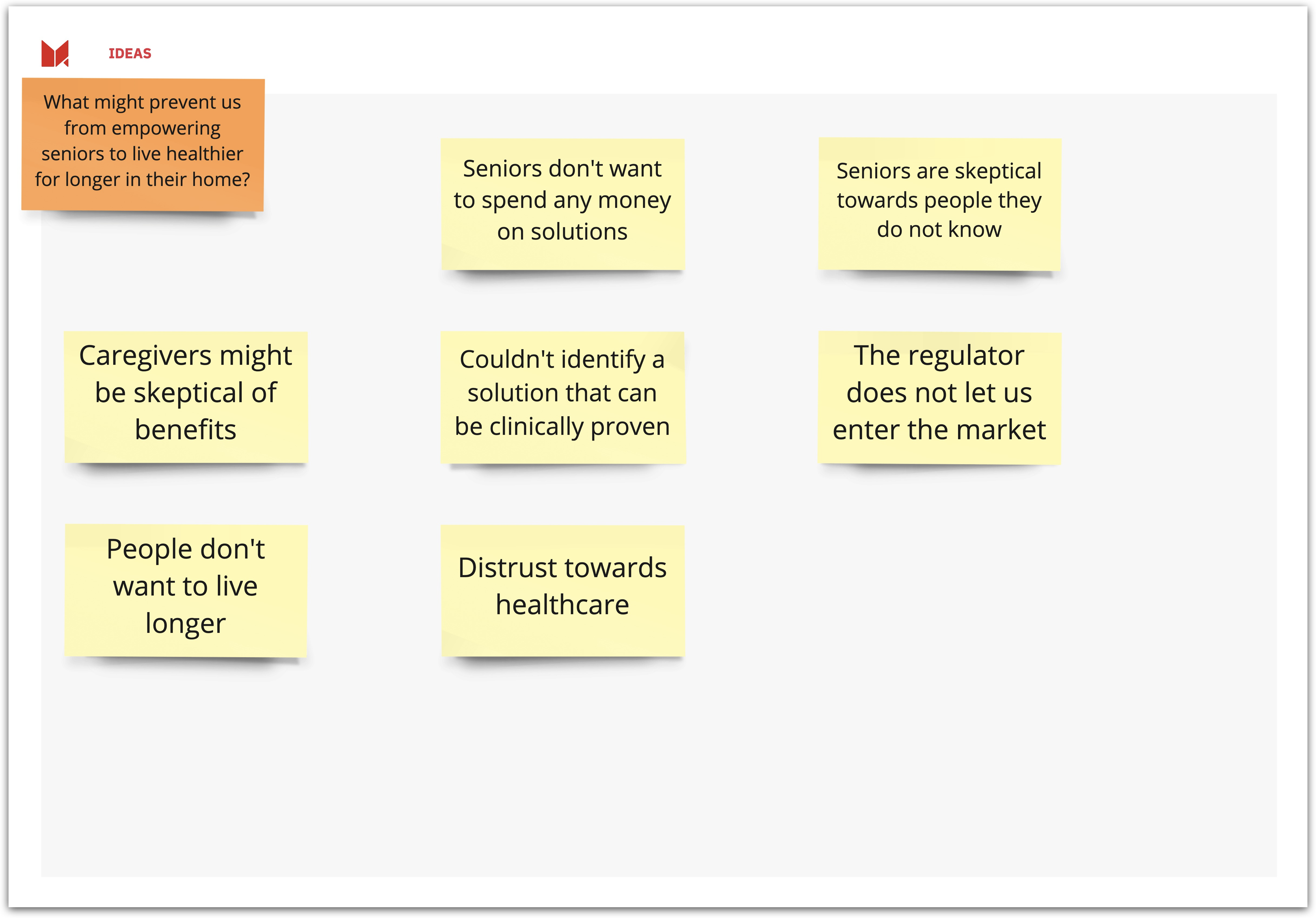
¶ “What If …?” Method
¶ What it is
This tool boosts your creativity by asking “What If…?” questions with an unrealistic, hypothetical constraint (e.g., regarding time, space, technology, etc.).
¶ Why it is useful
Creative ideas and new workarounds can be generated by forcing the team to consider a “mission impossible" scenario with exaggerated constraints.
¶ When to use it
The “What if…?” tool is part of the ideation phase and is another tool to generate ideas. Use this tool when you consider project constraints (e.g., time or budget) or when you are afraid that the ideas generated will not be creative or revolutionary. Imposing unnatural restrictions will reveal some workarounds that might not have come up otherwise.
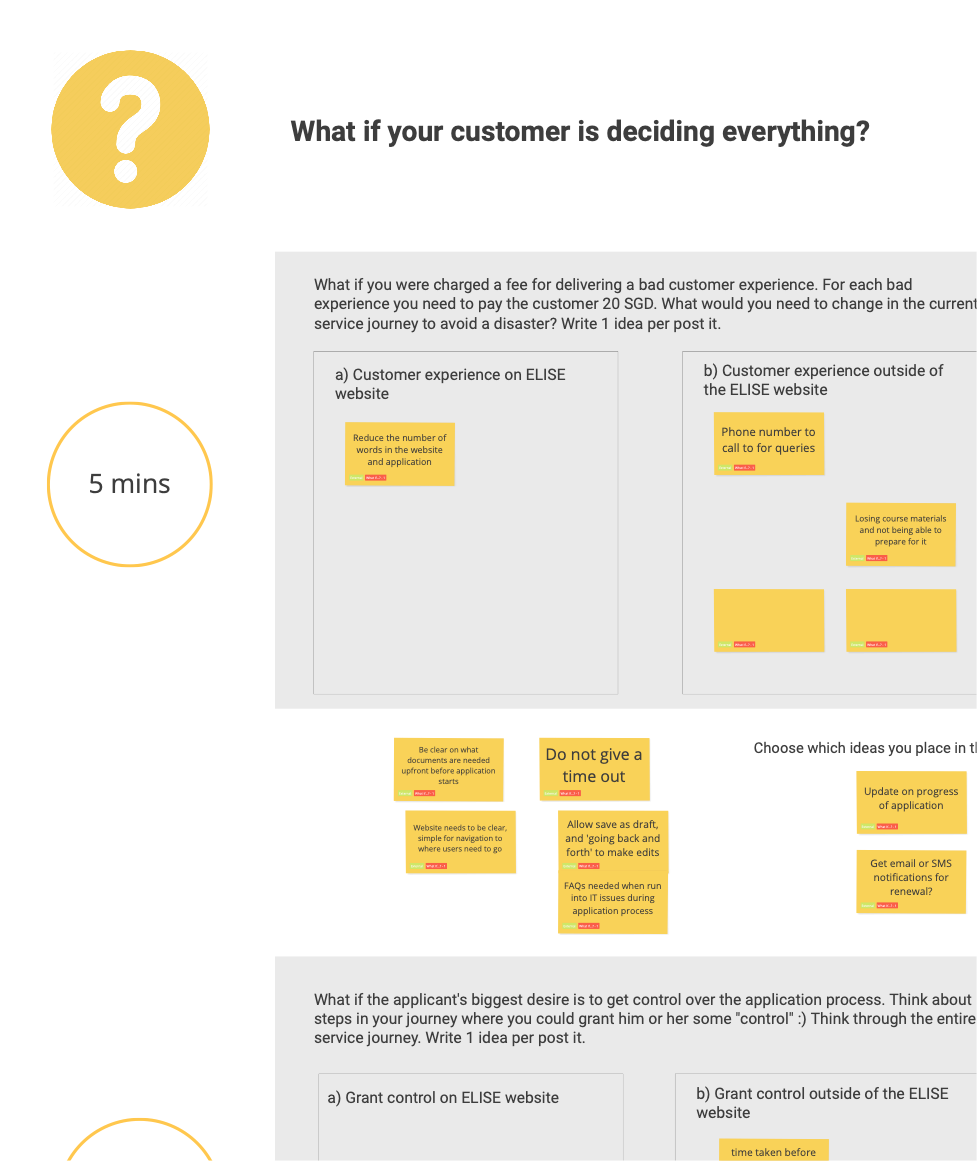
¶
¶ How is it done
- Develop seemingly impossible questions with unnatural, extreme constraints regarding time, space, actions required, technology, etc. Then, write the constrained question on the whiteboard by starting with "What If…?” (e.g., What if you had only 1 minute to apply for a license).
- Individually, take 5-10 minutes, brainstorm creative ideas to answer the “What If..?” question, and write them on post-its.
- Discuss the answers on the board. Then, develop them further and discuss how they could be used without constraints in the actual service context.
¶ Do's & Don't
Do's
- You can iterate around the same “What If…?” questions with different constraints in multiple rounds - how do ideas change depending on the constraint? Can some ideas meet the “What If…?” questions with simultaneous constraints?
Don't
- Do not get intimidated by the constraints - they are specifically chosen to make the “What If…?” impossible. Instead, focus on what is most important in the extreme situation. What are the prioritised steps? How else could you reach the goal?
¶ Tools needed
- Whiteboard (virtual)
- Post-its, paper, pen (virtual)
¶
¶ Example
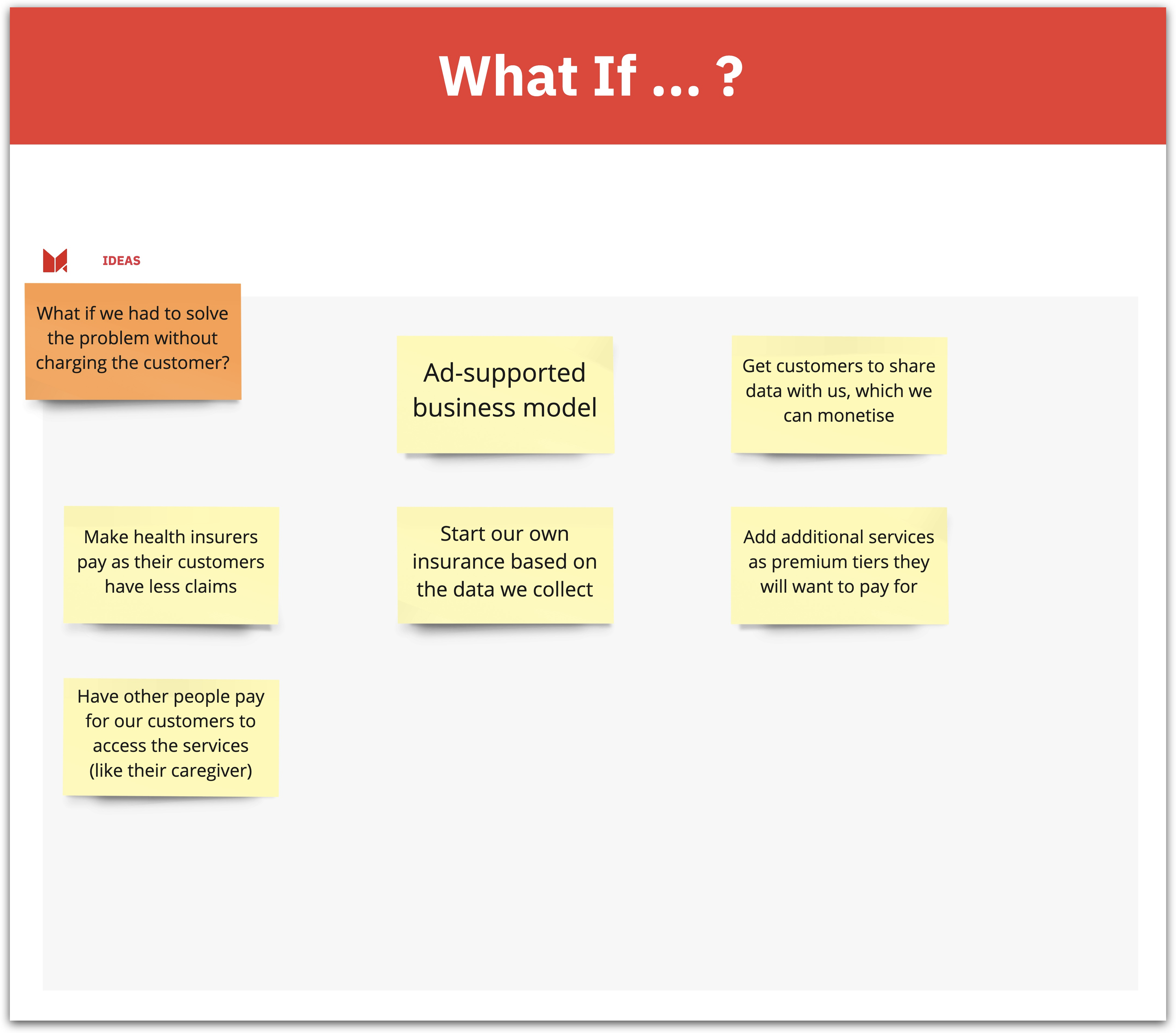
¶ Mindmap
¶ What it is
A Mind Map visually organises ideas around a central idea. Like tree branches, sub-ideas and related keywords are extended from the main idea. Ideas become more granular the further away they are noted from the central idea.
¶ Why it is useful
By sorting your ideas into clusters around the central idea, you logically extend them. The Mind Map structures your thinking and visualises key categories of ideas. This helps to get an overview and is the base for further developing your ideas.
¶ When to use it
Use a Mind Map whenever your project needs to organise information to understand better what you have achieved in your ideation. Instead of jumping straight to far-fetched ideas, you can build clusters related to your main topic and then spin thoughts further.
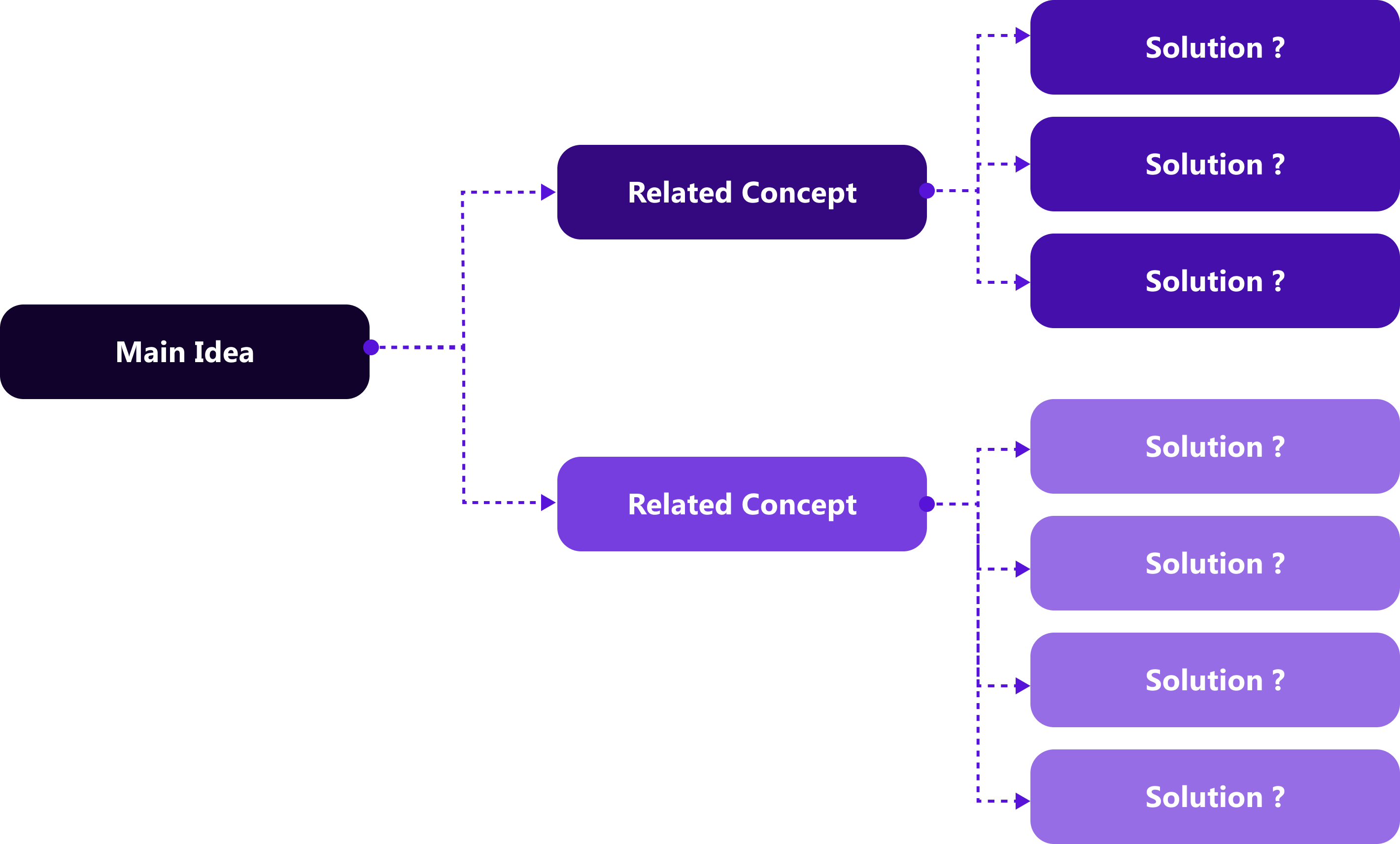
¶
¶ How is it done
- Decide on the central idea you would like to evolve further. Write the keyword in the middle of a whiteboard or paper.
- Extend the Mind Map around the central idea with branches. These are the main themes related to your central idea. Name each branch or bubble with a keyword or short description.
- Add as many smaller branches connected to the main themes as you need. Then, the Mind Map will extend and keep growing during the exercise!
¶ Do's & Don't
Do's
- Write down your associations freely as they come to your mind - you could focus on one central theme with its branches first or add new branches to different themes simultaneously.
- You can color code your mind map in different ways:
- All small branches coming out of one central theme to grasp the complexity of that theme
- Each level of thought with the same color (e.g., main themes red, 1st order branches blue, 2nd order branches yellow, etc.)
Don't
- Don’t worry about writing down wordy explanations - short keywords are more than enough.
¶ Tools needed
- Whiteboard (virtual)
- Post-its, paper, pen (virtual)
¶
¶ Example
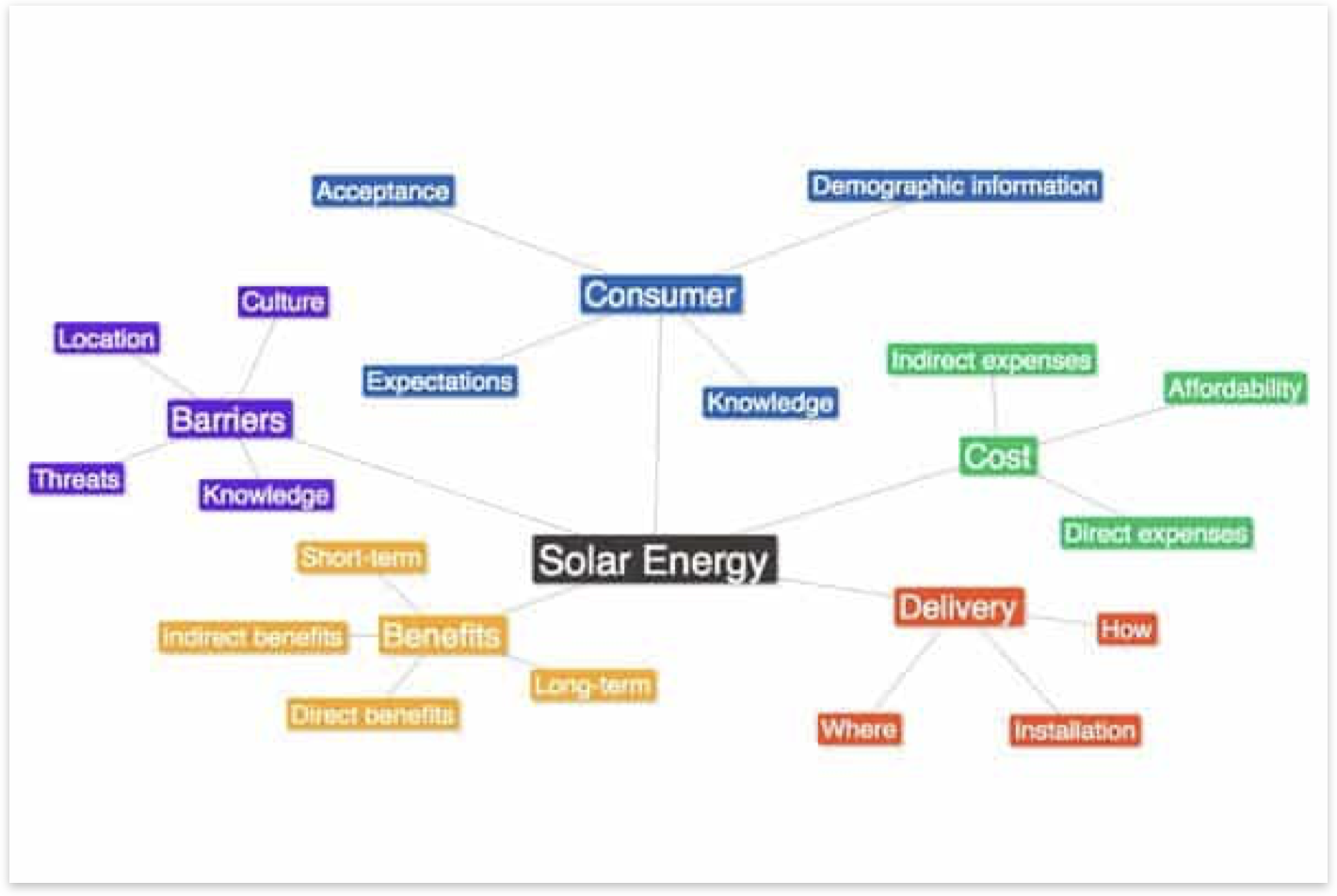
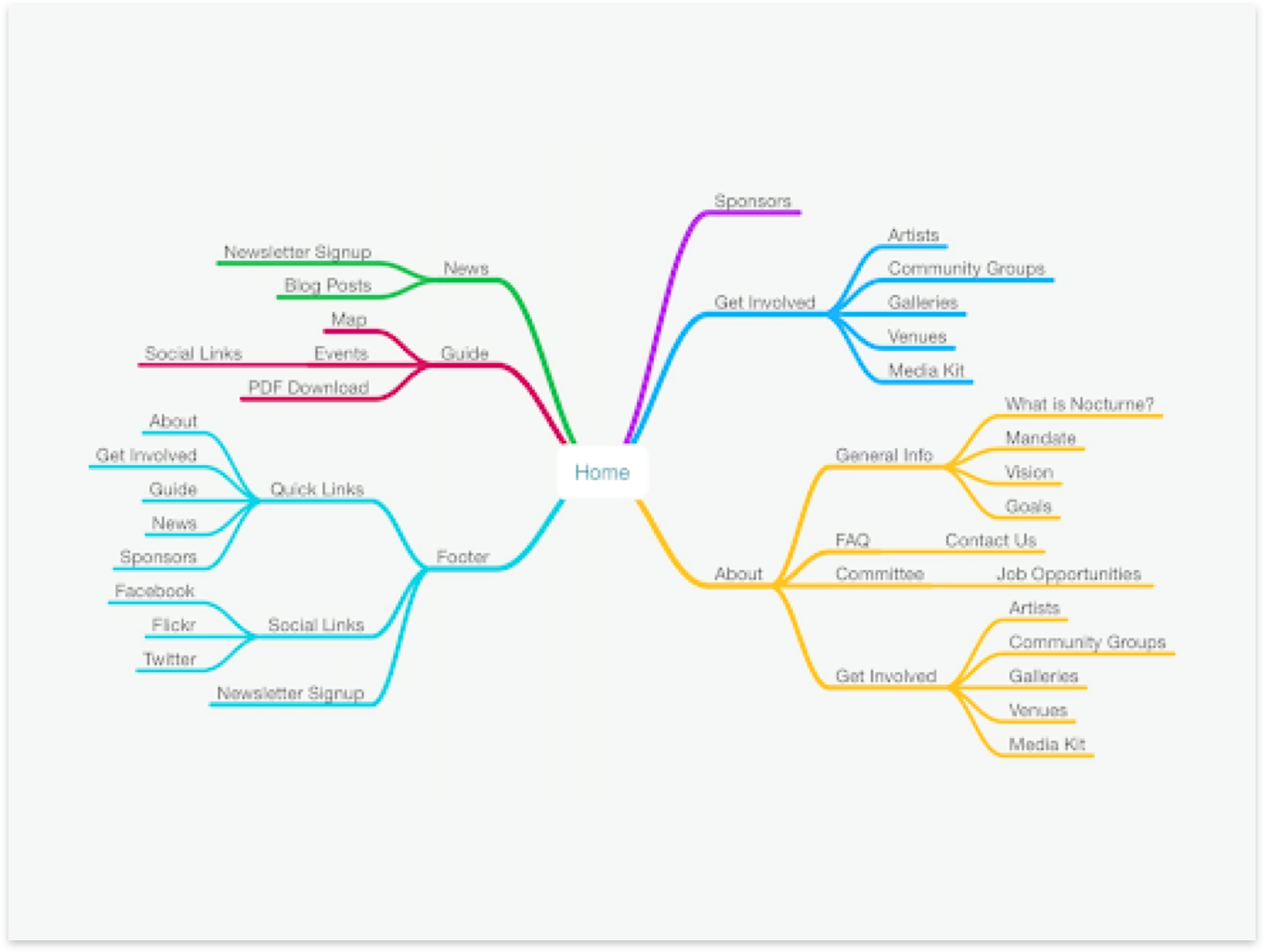
¶ Useful Tips
¶ Running a Successful Ideation Workshop
The Ideation phase is mainly driven by teamwork and the collective generation of ideas. Workshops are a great way to spark as many ideas as possible from people with different perspectives and diverse expertise. Keeping in mind the different components of the Ideation phase and the ultimate goal - a concept that can move into the Prototyping phase - will help to set up the workshop correctly. You can also consider the helpful tips regarding workshop preparation in the Empathy phase.
Activate participants’ creative thinking
Opening the workshop on the correct terms is crucial, as people have to be open to creative thinking. Make sure to mention that the workshop is a safe space to think loudly and openly and that there are no right or wrong ideas. Consider these warm-up activities at the beginning:
- Elephant: Ask participants to tear the shape of an elephant from a paper behind their backs. This will trigger people’s phantasy and create a relaxed, positive atmosphere.
- Imagery: Show participants pictures to get them inspired and in a “Think big” mindset. Images could be of impressive landscapes, happy people, or abstract art.
Insight Statements
Insight Statements derived from your research are the basis for your ideation activity. Have them ready and ask the participants to ideate around these statements.
Developing ideas
After using some of the ideation tools, you will end up with many ideas on the board. Build clusters with overlapping ideas or similar themes. By combining different ideas, you can develop new, more powerful concepts which can then be voted on and prioritised to move into prototyping.
¶ Challenges of Online Workshops
Moving group workshops into an online setting causes dynamics changes, which can hamper team creativity and collaboration. Understanding how remote workshops are different from physical ones can help to adapt well.
Increased levels of distraction
In a remote environment, primarily when people work from home, there are many distractions around them. The screen only occupies a small amount of space for every participant. All the remaining space might offer plenty of distractions. Therefore, keeping people engaged becomes even more critical.
Increased reluctance to participate
When people enter an unfamiliar situation with unfamiliar attendees, the most common response is reluctance, which is the opposite of what we want in remote workshop settings. Therefore, special attention must be paid to every participant to include them in the session.
Reduced depth of communication
When we communicate, spoken words are only a part of the message. Other factors, such as intonation and body language, carry significant meaning. When we go remote, many of these qualities of communication are lost. Inadequate audio equipment leads to reduced sound quality and hence missing intonation cues. Webcams significantly reduce our field of vision on a person’s body language. Often people are also less physically expressive in front of a computer. Constructive criticism, lacking depth in intonation, can be taken as offensive.
Reduced effectiveness of tools and methods
Most of the tools and methods we have today to conduct workshops have been created for in-person settings, from the ubiquitous post-it notes and whiteboards to various brainstorming and ideation techniques, including break-out groups and similar methods. They work well when everyone gathers in the exact location, but not remotely. It is, therefore, essential to see beyond the concrete tool and think about its purpose. On the other hand, many tools and methods do have remote-ready equivalents.
¶ Facilitating Remote Workshops
Always arrive early
As the host, dial in at least 10 minutes before the session starts and open the room. Before dialling in, ensure that all tools work and that all necessary documents are ready and pre-loaded as needed. Then, get ready to document the workshop.
Start with ground rules
Start with a set of ground rules for a smooth workshop. This includes basic video call hygiene (e.g., the video should always be on; everyone should be on mute by default, etc.). You can further add participation rules if needed.
Have icebreakers prepared
People usually chat in smaller groups when gathering before the workshop begins. Unfortunately, this opportunity does not exist for your remote workshop — so make sure to allow people to warm up first. Icebreakers are essential to ensure everyone is familiar with each other and ready to engage.
Over-communicate
Repeat important information until you are sure that everyone is aligned. Explicitly ask for agreement rather than interpreting silence as agreement. Make sure everyone is on the same page and following along.
Make space for people to speak
As physical cues for when someone wants to speak (e.g., body language) are mainly absent from remote workshops, situations can quickly become chaotic. In general, the facilitator should only talk for 10 minutes straight, with at least pausing to pose a question or gather feedback. As the facilitator, you can also call on people by name or, for some exercises, ask the person speaking to call on the next one to speak after them.
Open and close well
When starting an exercise, you must ensure everyone understands the purpose, required engagement, and desired output. Similarly, once an exercise wraps up, close the activity by re-stating what was done and what outcomes were achieved. Further, it helps to highlight how the result of one part of the agenda connects to the next to keep people following along.
Guide participants through tools
Start using each new tool with one easy warm-up exercise that allows everyone to become familiar with or remember how to use it (e.g., by sharing your screen).
¶ Co-Creation Workshop
Instead of generating ideas only within your project team, consider running a co-creation session that involves real customers. By involving and empowering those you are designing for in the ideation process, you will likely increase your service's adoption and satisfaction rates and gain valuable insights.
Identify suitable participants
Decide whom you want to collaborate with in the Ideation phase. For example, you should involve people you have previously engaged with in the empathise phase or select other customers with specific demographics or expertise. You can use a screener to find participants with the characteristics you are looking for.
Engage participants
Use the workshop format to stimulate active exchange and collaboration between the participants. A strong facilitator is critical to managing the dynamics between the different groups.
Share decision-making
Listen to the stakeholders' ideas and feedback when co-creating, and treat them as full members of your design team. Empower them by giving them equal voting rights.
Take action
Show that you value the efforts of your stakeholders and the results from the co-creation workshop by using the outcomes for further ideation sessions or in the Prototyping phase.